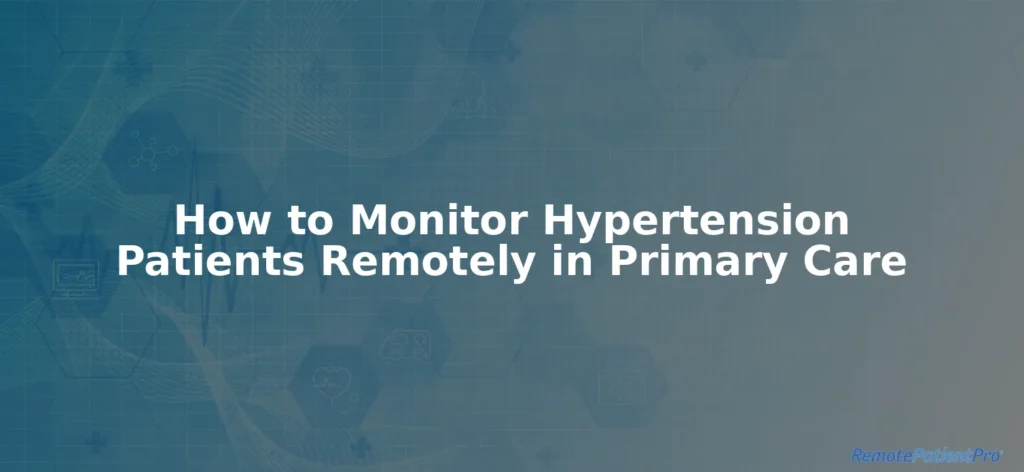How to Monitor Hypertension Patients Remotely in Primary Care
Hypertension — commonly known as high blood pressure — is a leading contributor to cardiovascular diseases. Monitoring it effectively requires continuous oversight and timely interventions, which can be challenging for primary care providers who rely solely on in-office visits. Remote patient monitoring (RPM) provides a convenient, efficient, and accurate way to manage hypertension by improving patient outcomes and standardizing care delivery. At TriageLogic, we specialize in providing comprehensive RPM solutions that help primary care providers effectively monitor hypertension patients from the comfort of their homes.
Why Remote Monitoring Is Essential for Hypertension Management
- Improved Accessibility
Remote monitoring removes barriers like travel distance and scheduling difficulties, making care more accessible for patients. - Real-Time Insights
RPM provides continuous data on blood pressure trends to identify potential complications. - Better Patient Engagement
Patients can track their own symptom progress to encourage greater accountability and adherence to treatment plans. - Reduced Healthcare Costs
Fewer in-person visits and hospitalizations lead to significant cost savings for both patients and providers. - Enhanced Provider Efficiency
Automating data collection and alerts allows providers to focus on high-priority cases.
Learn more about hypertension management best practices from the Centers for Disease Control and Prevention.
Steps to Monitor Hypertension Patients Remotely in Primary Care
1. Equip Patients With Monitoring Devices
- Provide patients with Bluetooth-enabled or cellular-connected blood pressure monitors that transmit data automatically.
2. Implement a Secure RPM Platform
- Use a HIPAA-compliant RPM solution to collect, analyze, and store patient data securely.
- Platforms like TriageLogic’s RemotePatientPro™ offer intuitive dashboards for uninterrupted data access.
3. Educate Patients on Device Usage
- Offer clear instructions and tutorials to ensure patients can use their devices effectively.
- Provide ongoing support to address any technical issues.
4. Set Alerts for Abnormal Readings
- Configure the RPM platform to send notifications for abnormal blood pressure levels.
- Automate alerts to enable timely provider interventions.
5. Schedule Regular Virtual Consultations
- Conduct follow-up consultations via telehealth to review progress and adjust treatment plans.
6. Integrate Data With EHR Systems
- Sync RPM data with electronic health records (EHRs) for complete documentation and comprehensive care.
7. Review and Adjust Care Plans as Needed
- Use real-time insights to refine treatment plans based on each patient’s progress and trends.
Benefits of Remote Hypertension Monitoring
- Early Detection of Complications
Continuous monitoring helps identify issues before they escalate, reducing the risk of hospitalization. - Personalized Treatment
RPM data allows providers to customize care plans based on individual patient needs. - Increased Patient Satisfaction
Convenient remote monitoring minimizes disruptions to patients’ daily lives while maintaining high-quality care. - Scalable Solutions
RPM platforms can accommodate growing patient volume without straining resources.
Conditions Managed Alongside Hypertension
- Heart Disease: Monitor heart rate and rhythm to prevent complications.
- Diabetes: Track blood pressure alongside glucose levels for holistic management.
- Chronic Kidney Disease: Manage blood pressure to reduce the risk of kidney damage.
How RemotePatientPro Supports Hypertension Monitoring
We provide a comprehensive suite of RPM tools and services to help primary care providers monitor hypertension patients effectively.
- Advanced Monitoring Devices: Reliable, easy-to-use blood pressure monitors with real-time data transmission.
- Custom Alerts: Automated notifications for abnormal readings to ensure timely interventions.
- HIPAA-Compliant Platforms: Secure systems for data collection, storage, and analysis.
- Integrated EHR Syncing: Seamless connections to share patient data within your existing systems.
- Patient Education: Resources and support to help patients maximize the benefits of remote monitoring.
Explore the American Heart Association’s guidelines on hypertension management for more information on best practices and care strategies.
Frequently Asked Questions
Q: What type of devices are used for remote hypertension monitoring?
A: Common devices include digital blood pressure monitors equipped with Bluetooth or cellular connectivity for real-time data transmission.
Q: Is remote monitoring suitable for all hypertension patients?
A: While RPM is highly effective for most patients, providers may assess individual suitability based on factors like technology access and health conditions.
Q: How does RemotePatientPro benefit hypertension monitoring?
A: RPP offers end-to-end RPM solutions with real-time data tracking, automated alerts, and patient-friendly platforms for expedited care.
Transform Hypertension Care With Remote Monitoring
Remote monitoring empowers primary care providers to deliver proactive, efficient care for their hypertension patients. By integrating advanced RPM tools, you can improve patient outcomes, reduce healthcare costs, and achieve operational excellence.
We’re committed to providing the best solutions to support your success. Contact us today to learn more about our RPM solutions for hypertension management in primary care.

